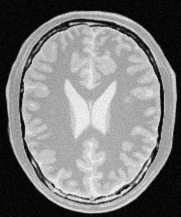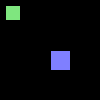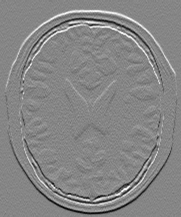Compute Derivative#
Synopsis#
This filter computes a n-th Derivative of a scalar-valued image in a specified direction.
Results#

Input image#

Output image#

Output normalized image#
Code#
C++#
// Software Guide : BeginCommandLineArgs
// INPUTS: {BrainProtonDensitySlice.png}
// ARGUMENTS: {DerivativeImageFilterFloatOutput.mhd}
// OUTPUTS: {DerivativeImageFilterOutput.png}
// ARGUMENTS: 1 0
// Software Guide : EndCommandLineArgs
// Software Guide : BeginLatex
//
// The \doxygen{DerivativeImageFilter} is used for computing the partial
// derivative of an image, the derivative of an image along a particular
// axial direction.
//
// \index{itk::DerivativeImageFilter}
//
// Software Guide : EndLatex
#include "itkImage.h"
#include "itkImageFileReader.h"
#include "itkImageFileWriter.h"
#include "itkRescaleIntensityImageFilter.h"
// Software Guide : BeginLatex
//
// The header file corresponding to this filter should be included first.
//
// \index{itk::DerivativeImageFilter!header}
//
// Software Guide : EndLatex
// Software Guide : BeginCodeSnippet
#include "itkDerivativeImageFilter.h"
// Software Guide : EndCodeSnippet
int
main(int argc, char * argv[])
{
if (argc < 6)
{
std::cerr << "Usage: " << std::endl;
std::cerr << argv[0] << " inputImageFile outputImageFile normalizedOutputImageFile ";
std::cerr << " derivativeOrder direction" << std::endl;
return EXIT_FAILURE;
}
// Software Guide : BeginLatex
//
// Next, the pixel types for the input and output images must be defined
// and, with them, the image types can be instantiated. Note that it is
// important to select a signed type for the image, since the values of the
// derivatives will be positive as well as negative.
//
// Software Guide : EndLatex
// Software Guide : BeginCodeSnippet
using InputPixelType = float;
using OutputPixelType = float;
constexpr unsigned int Dimension = 2;
using InputImageType = itk::Image<InputPixelType, Dimension>;
using OutputImageType = itk::Image<OutputPixelType, Dimension>;
// Software Guide : EndCodeSnippet
using ReaderType = itk::ImageFileReader<InputImageType>;
using WriterType = itk::ImageFileWriter<OutputImageType>;
auto reader = ReaderType::New();
auto writer = WriterType::New();
reader->SetFileName(argv[1]);
writer->SetFileName(argv[2]);
// Software Guide : BeginLatex
//
// Using the image types, it is now possible to define the filter type
// and create the filter object.
//
// \index{itk::DerivativeImageFilter!instantiation}
// \index{itk::DerivativeImageFilter!New()}
// \index{itk::DerivativeImageFilter!Pointer}
//
// Software Guide : EndLatex
// Software Guide : BeginCodeSnippet
using FilterType = itk::DerivativeImageFilter<InputImageType, OutputImageType>;
auto filter = FilterType::New();
// Software Guide : EndCodeSnippet
// Software Guide : BeginLatex
//
// The order of the derivative is selected with the \code{SetOrder()}
// method. The direction along which the derivative will be computed is
// selected with the \code{SetDirection()} method.
//
// \index{itk::DerivativeImageFilter!SetOrder()}
// \index{itk::DerivativeImageFilter!SetDirection()}
//
// Software Guide : EndLatex
// Software Guide : BeginCodeSnippet
filter->SetOrder(std::stoi(argv[4]));
filter->SetDirection(std::stoi(argv[5]));
// Software Guide : EndCodeSnippet
// Software Guide : BeginLatex
//
// The input to the filter can be taken from any other filter, for example
// a reader. The output can be passed down the pipeline to other filters,
// for example, a writer. An \code{Update()} call on any downstream filter
// will trigger the execution of the derivative filter.
//
// \index{itk::DerivativeImageFilter!SetInput()}
// \index{itk::DerivativeImageFilter!GetOutput()}
//
// Software Guide : EndLatex
// Software Guide : BeginCodeSnippet
filter->SetInput(reader->GetOutput());
writer->SetInput(filter->GetOutput());
writer->Update();
// Software Guide : EndCodeSnippet
// Software Guide : BeginLatex
//
// \begin{figure}
// \center
// \includegraphics[width=0.44\textwidth]{BrainProtonDensitySlice}
// \includegraphics[width=0.44\textwidth]{DerivativeImageFilterOutput}
// \itkcaption[Effect of the Derivative filter.]{Effect of the Derivative
// filter on a slice from a MRI proton density brain image.}
// \label{fig:DerivativeImageFilterOutput}
// \end{figure}
//
// Figure \ref{fig:DerivativeImageFilterOutput} illustrates the effect of
// the DerivativeImageFilter on a slice of MRI brain image. The derivative
// is taken along the $x$ direction. The sensitivity to noise in the image
// is evident from this result.
//
// Software Guide : EndLatex
using WriteImageType = itk::Image<unsigned char, Dimension>;
using NormalizeFilterType = itk::RescaleIntensityImageFilter<OutputImageType, WriteImageType>;
using NormalizedWriterType = itk::ImageFileWriter<WriteImageType>;
auto normalizer = NormalizeFilterType::New();
auto normalizedWriter = NormalizedWriterType::New();
normalizer->SetInput(filter->GetOutput());
normalizedWriter->SetInput(normalizer->GetOutput());
normalizer->SetOutputMinimum(0);
normalizer->SetOutputMaximum(255);
normalizedWriter->SetFileName(argv[3]);
normalizedWriter->Update();
return EXIT_SUCCESS;
}
Classes demonstrated#
-
template<typename TInputImage, typename TOutputImage>
class DerivativeImageFilter : public itk::ImageToImageFilter<TInputImage, TOutputImage> Computes the directional derivative of an image. The directional derivative at each pixel location is computed by convolution with a derivative operator of user-specified order.
SetOrder specifies the order of the derivative.
SetDirection specifies the direction of the derivative with respect to the coordinate axes of the image.
- See
Image
- See
Neighborhood
- See
NeighborhoodOperator
- See
NeighborhoodIterator
- ITK Sphinx Examples:
